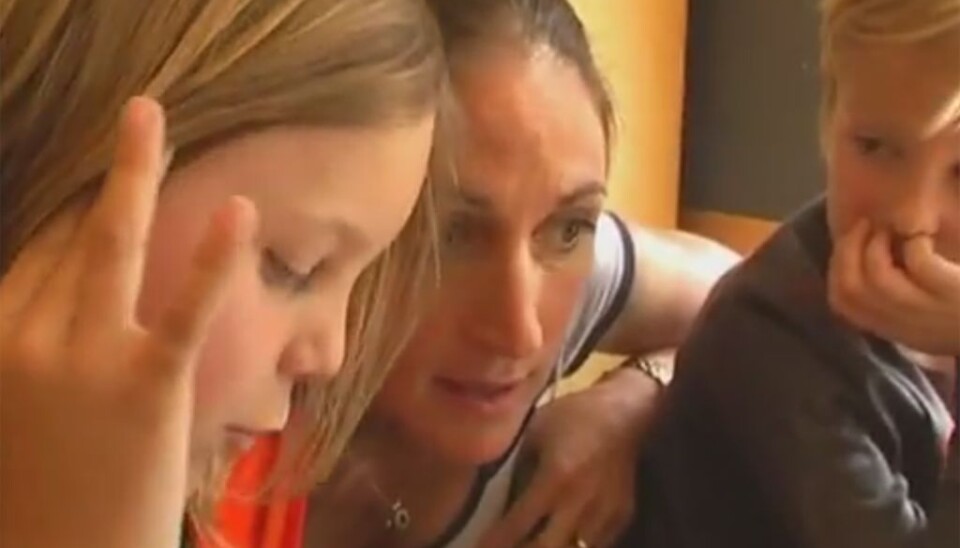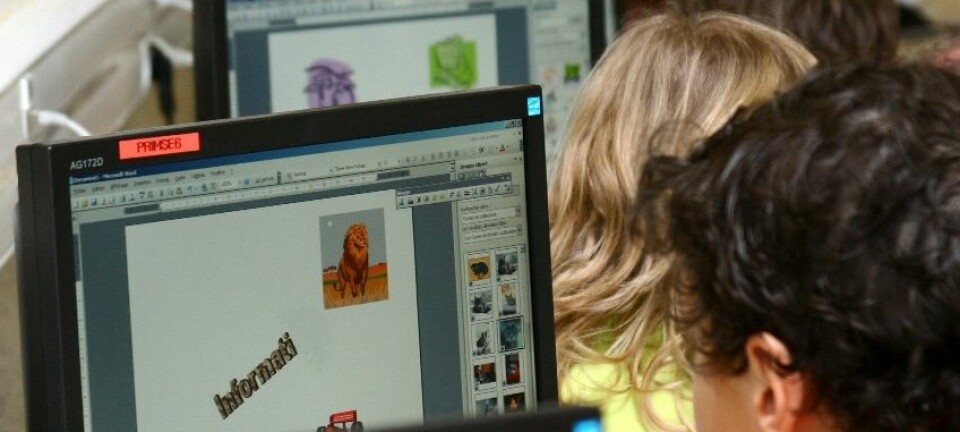
Using keyboards before pencils
Swedish first-grade children in a pilot project are starting to read, learn and network socially. They’re doing this - successfully - by writing on PCs and discussing their texts with peers and teachers.
Denne artikkelen er over ti år gammel og kan inneholde utdatert informasjon.
Viktor, Marcus and William have written a clever riddle - not that surprising, perhaps, for seven-year-olds in the first grade.
But what might surprise some is that the trio wrote their riddle on a computer, long before they learned how to write with pen and paper.
Viktor, Marcus and William are students in a primary school in Sollentuna, a wealthy suburb north of Stockholm that has an expressed goal of providing the best education in Sweden.
With that in mind, their teacher Annika Agélii Genlott has experimented with letting first-graders learn to read by writing on a computer before learning to write by hand.

The idea is that handwriting demands dexterity and motor skills that many six-year-olds lack.
So writing with a pencil has been postponed until second grade. And if Genlott's approach is right, these kids aren’t stressed by attempting to learn too many mental and motor skills at once.
Wrote like third graders
Genlott, working with Professor Åke Grönlund of Örebro University, has discovered that the kids in the experimental scheme could read and write better than schoolmates who had been taught using standard methods.
Their texts were longer, had a more lucid narrative and flowed more logically, according to an article published in the journal Computers & Education.

Towards the end of the first school year they were writing like kids in third grade, the educators say. Their reading skills were also bolstered. The share of fast readers increased strongly.
Social computer network
The method is not new. It’s called Write to Read, WTR. Computers and WTR have been combined in classrooms since the 1980s.
PCs used to be relegated to a special computer room. Now they have made their way into regular classrooms, opening new opportunities.
In the Sollentuna project, Write to Read is being used in more than teaching the mother tongue, Swedish. It’s also used for mathematics.
Most importantly, the pupils can use a digital social network to comment on their writing with one another. This is why the new variation is called Integrated Write to Learn, iWTR.
Learning the Internet smarts
Retired research Arne Trageton has worked with Write to Read in Norway since the start of the millennium. He has also written a book on the subject.
Trageton has kept an eye on the project in Sollentuna. He thinks the networking aspect, a circle of kids who comment on each other’s work, is one of the key advantages. Writing is a social activity. We write to reach out to other people.
“The social commentary function stimulates the pupils to read. They also learn how to write a meaningful comment and conduct themselves well in social media,” he says.
“I’m looking forward to when these kids reach the Facebook age. Blogger and commentary areas will get more content and be more interesting to read,” says Trageton.
Synthetic speech support
The researchers at Sollentuna also use synthetic speech as a tool. As the pupils write the computer speaks what they have written.
Synthetic speech proved to be useful in two ways. It functioned as an oral spell-check. The kids heard through the PC speakers that they were spelling incorrectly.
Secondly, slower learners could use it for reading support. It helped them avoid being shut out of any digital interaction with their schoolmates.
Avoiding defeat
Trageton thinks a keyboard and a computer provide the best introduction to written language − also for those who aren’t the most able.
“If you are forced to write by hand before you’ve acquired the motor skills, you encounter defeat already in first grade. This is particularly a problem for boys,” he says.
“Defeats can be devastating for reading skills. Future high school drop-outs start losing confidence in first grade when they experience shortcomings,” says Trageton.
Liberated energy
While regular first-graders toil with eraser smears, crumpled sheets of paper and lack of space at the end of a line, kids with keyboards are writing their ABCs and they look just as good, every single time.
Energy and interest in schoolwork can be channelled to important things: Expressing their own thoughts, interacting with their schoolmates’ ideas and acquiring knowledge, according to the iWTR method.
Teacher is important
The teacher is far from superfluous in the classroom when computers are brought in as writing tools. On the contrary.
“For social learning via a computer network to function, you need a skilled teacher as an organiser and dialogue partner,” says Trageton.
Fewer machines, more research
However, Trageton is sceptical about the kinds of pressure the computer industry might exert on schools to buy PCs.
“In Sweden I’ve seen the result of ad campaigns for an iPad for every pupil. My experience is that children should write in pairs on a PC,” he says.
By working in pairs, the pupils can develop their abilities to converse and cooperate.
Trageton thinks that if Sweden and Sollentuna had allocated less to computer equipment, they would have more to spend on the Write to Learn method.
In any case, the research is underway. Genlott and Grönlund have initiated a new test with eight first-grade classes.
These tests will provide better documentation of the method that uses digital tools for typing and discussions, inspiring youngster to learn reading and social skills.
The results show that while reading skills were improved considerably, the biggest improvement was in writing skills. Students in the test group wrote longer texts with better structure, clearer content, and more elaborate language.
Translated by: Glenn Ostling

































